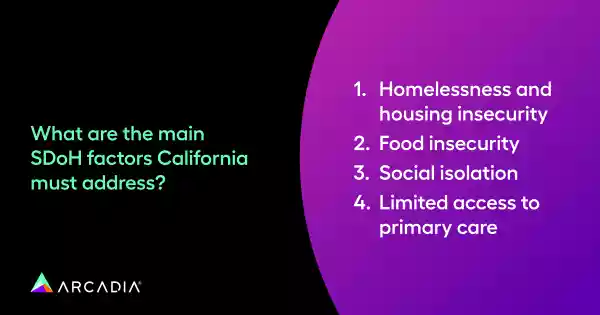What are the main barriers to health equity in California?
Social determinants of health are a hot-button issue nationwide, but California’s greatest SDoH hurdles — from homelessness to social isolation — reflect its diverse population.
In California, a state known for its technological and cultural advancements, the health outcomes of its residents are significantly influenced by Social Determinants of Health (SDoH). These determinants are the conditions in the environments where people are born, live, learn, work, play, and age, and they affect a wide range of health, functioning, and quality-of-life outcomes and risks. They’re a major consideration in the quest for health equity, the effort to reduce disparities across different populations.
While these factors impact healthcare nationwide, they vary across regions, and each state will face unique challenges to achieve health equity for their citizens. Here, we’ll explore the specific SDoH factors driving poor health outcomes in California and take a look at how data analytics can play a crucial role in addressing these challenges.

What are the main SDoH factors California must address?
In a state with a population of about 39 million, 6.6. million of whom are enrolled in Medicare, and major differentials in climate and culture from north to south, these are the key challenges healthcare and governmental leadership must address in order to achieve health equity.
1. Homelessness and housing insecurity
California faces a significant homelessness crisis, which directly impacts the health of its citizens. Lack of stable housing leads to increased exposure to environmental hazards, poor nutrition, and heightened stress levels, all of which contribute to deteriorating health. The link between homelessness and health outcomes is undeniable, and addressing this issue is crucial for improving the overall health of Californians.
2. Food insecurity
Afflicting an estimated 1 in 5 Californians, another critical factor to achieve health equity is food insecurity. The inability to access nutritious food consistently leads to various health issues, including chronic diseases like diabetes and heart disease. Food insecurity often goes hand in hand with poverty, creating a cycle that is hard to break without adequate support and resources.
3. Social isolation
Social isolation, exacerbated by the recent global pandemic, has become a prominent issue in California. It negatively affects mental health, leading to conditions such as depression and anxiety. The impact of social isolation extends to physical health, with studies showing a correlation between loneliness and chronic health conditions.
4. Limited access to primary care
Primary care doctors are in short supply nationwide, but the shortage of these physicians and practitioners in California, especially in rural and underserved areas, is a significant barrier to achieving optimal health outcomes. Primary care physicians are often the “first responders” who see a particular issue and route a patient to the right care. This gap in the healthcare system means that many Californians do not receive timely and adequate healthcare, leading to worsened health conditions and increased healthcare costs in the long run.
How can California healthcare leaders solve these issues?
A long journey to equity begins with a few initial steps, and to make an action plan that works, data is critical. To address these SDoH factors effectively, healthcare administrators and executives in California need to leverage data analytics.
Data analytics provide valuable insights into the root causes of these issues and help in designing targeted interventions. Patient stratification helps care managers target interventions with the most potential impact, and comprehensive records (including information pulled from payers, EHRs, and public health data) give providers at the point of care a sharper sense of what resources their patients need. By analyzing data from these varied sources, healthcare leaders can identify trends, predict outcomes, and allocate time and money more effectively to address the specific needs of their communities.
This programming might even go beyond the traditional approaches inside a hospital’s walls. When wildfires raged a state away, in Oregon, Umpqua Health zeroed in on patients who were especially vulnerable, and took action to distribute at-home air filters that prevented further disaster. In any situation where SDoH factors are negatively shaping health, a useful plan of action starts with a granular knowledge of who’s impacted and how, which will help healthcare innovators find novel ways to intervene.
Data for the Golden State’s bright healthcare future
The health of Californians is deeply impacted by various social determinants, as intricate and diverse as the people living in the state. Addressing issues like homelessness, food insecurity, social isolation, and the lack of primary care requires a comprehensive and data-driven approach, but California is the land of technological innovation and progressive ideas. With the right tools and forward-thinking leadership, a more equitable healthcare landscape is possible in the Golden State.
Learn more about how data analytics can brighten California’s healthcare future:
